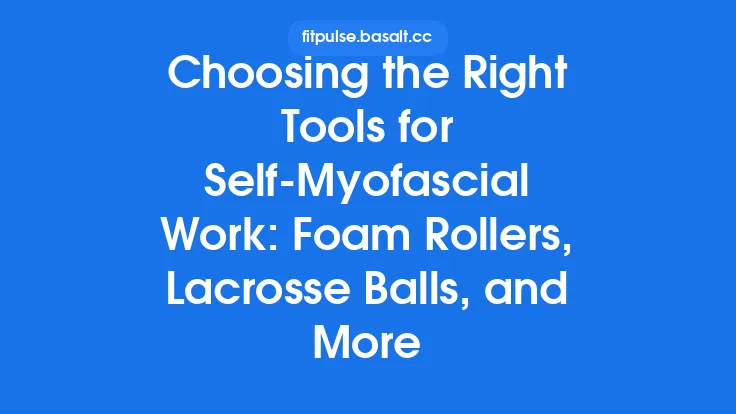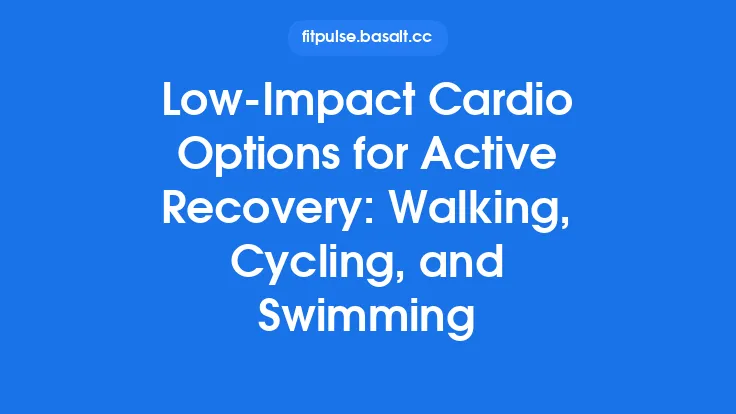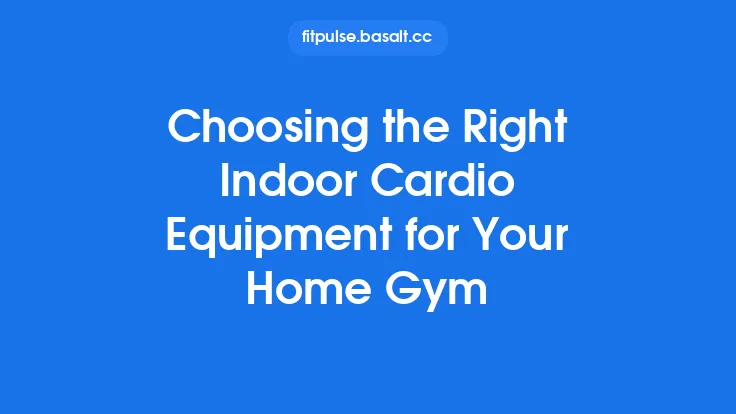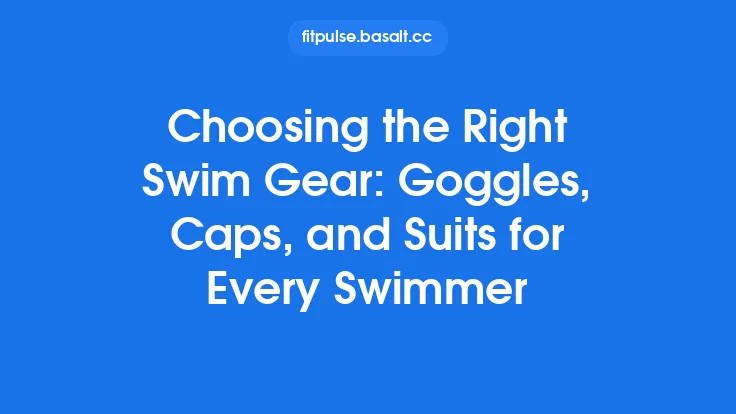Low‑Intensity Steady‑State (LISS) cardio is prized for its accessibility, sustainability, and the gentle yet consistent demand it places on the cardiovascular system. While the underlying physiology of LISS is well‑documented, the practical question many exercisers face is which modality best aligns with their goals, lifestyle, and physical profile. Walking, cycling, elliptical training, rowing, and even low‑impact alternatives such as water walking each bring a distinct blend of biomechanical demands, energy costs, and logistical considerations. This article walks you through the key factors to evaluate when selecting a LISS modality, helping you tailor your cardio practice to your unique circumstances.
1. Core Criteria for Modality Selection
Before diving into the specifics of each activity, it’s useful to establish a decision‑making framework. The following parameters consistently influence the suitability of a LISS option:
| Criterion | What to Assess | Why It Matters |
|---|---|---|
| Joint Load & Kinematics | Peak joint forces, range of motion, impact frequency | Determines suitability for individuals with joint sensitivities, arthritis, or previous injuries |
| Muscle Group Emphasis | Primary movers, stabilizers, antagonists | Aligns cardio with broader strength or mobility goals |
| Energy Expenditure (kcal/hr) | Measured at comparable heart‑rate zones (e.g., 50‑65 % HRmax) | Influences time efficiency and fat‑oxidation potential |
| Accessibility & Cost | Equipment availability, space requirements, subscription fees | Affects long‑term adherence |
| Environmental Variables | Indoor vs. outdoor, weather dependence, terrain variability | Impacts consistency and psychological enjoyment |
| Technical Skill & Learning Curve | Coordination demands, balance requirements | Influences safety and confidence for beginners |
| Progression Flexibility | Ability to adjust resistance, incline, speed, or duration | Supports gradual overload without leaving the LISS intensity band |
| Psychological Engagement | Perceived enjoyment, monotony tolerance, social aspects | Strong predictor of adherence over months and years |
By rating each modality against these criteria, you can construct a personalized hierarchy that guides your choice.
2. Walking
Biomechanics & Joint Impact
Walking is the archetype of low‑impact movement. Ground reaction forces typically peak at 1–1.2 × body weight, far below the 2–3 × body weight seen in jogging. The motion is primarily sagittal, involving hip flexion/extension, knee extension, and ankle plantar‑dorsiflexion, with minimal lateral stress.
Muscle Activation Profile
- Primary: Gluteus maximus, hamstrings, quadriceps, gastrocnemius/soleus.
- Stabilizers: Core musculature (erector spinae, obliques) and hip abductors for gait stability.
Energy Expenditure
At a brisk pace of 4 mph (≈6.4 km/h) and a heart‑rate zone of 55 % HRmax, a 70 kg individual burns roughly 250–300 kcal per hour. Incline walking (e.g., treadmill grade 5–7 %) can raise this to 350–400 kcal/hr while still staying within LISS intensity.
Practical Considerations
- Accessibility: No equipment required; sidewalks, parks, or indoor tracks suffice.
- Cost: Free, aside from footwear.
- Progression: Adjust speed, incline, or incorporate weighted vests.
- Limitations: Weather dependence for outdoor walking; limited upper‑body involvement.
3. Cycling (Stationary & Outdoor)
Biomechanics & Joint Load
Cycling is a non‑weight‑bearing activity; the seat supports a large portion of body weight, reducing compressive forces on the knees and hips to roughly 0.5–0.8 × body weight. Pedal stroke is a closed kinetic chain with a predominantly concentric phase (downstroke) and a brief eccentric phase (upstroke).
Muscle Activation Profile
- Primary: Quadriceps (vastus lateralis, medialis), gluteus maximus, hamstrings.
- Secondary: Calf muscles (gastrocnemius, soleus), hip flexors, and, when using a road bike, core stabilizers for balance.
Energy Expenditure
On a flat road or stationary bike at 50–60 % HRmax, a 70 kg rider typically expends 300–350 kcal/hr. Adding resistance (gear selection or stationary bike wattage) can increase caloric burn to 400 kcal/hr without exceeding LISS thresholds.
Practical Considerations
- Accessibility: Requires a bike (indoor trainer or outdoor bike).
- Cost: Moderate to high (bike purchase, maintenance, indoor trainer).
- Progression: Manipulate resistance, cadence, or terrain (hills).
- Limitations: Outdoor cycling is weather‑dependent; stationary bikes may feel monotonous without visual stimuli.
4. Elliptical Trainer
Biomechanics & Joint Load
Ellipticals simulate a running gait while keeping feet in constant contact with the footplates, virtually eliminating impact spikes. Joint moments are typically 30‑40 % lower than those observed during treadmill walking at comparable speeds.
Muscle Activation Profile
- Lower Body: Quadriceps, gluteus maximus, hamstrings, calves.
- Upper Body (if handles are used): Deltoids, pectorals, latissimus dorsi, biceps, triceps.
- Core: Engaged for stabilization, especially when alternating arm‑leg patterns.
Energy Expenditure
At a moderate resistance and a stride rate of 120–140 spm (steps per minute), a 70 kg user can burn 350–400 kcal/hr while maintaining a heart‑rate zone of 55–65 % HRmax.
Practical Considerations
- Accessibility: Requires a gym membership or home purchase.
- Cost: Mid‑range to high (machine price, maintenance).
- Progression: Adjust resistance, incline, and stride length.
- Limitations: Fixed motion path may feel restrictive; some users report a learning curve to achieve a smooth stride.
5. Rowing (Ergometer)
Biomechanics & Joint Load
Rowing is a full‑body, low‑impact activity that alternates between a drive phase (concentric) and a recovery phase (eccentric). The foot is fixed, and the motion is primarily in the sagittal plane, resulting in low joint compression forces (≈0.5 × body weight on the knees).
Muscle Activation Profile
- Lower Body: Quadriceps, gluteus maximus, hamstrings.
- Upper Body: Latissimus dorsi, trapezius, rhomboids, biceps, forearms.
- Core: Rectus abdominis, obliques, erector spinae for trunk stability.
Energy Expenditure
At a steady stroke rate of 20–24 spm and a resistance setting that keeps heart rate within 55–65 % HRmax, a 70 kg individual typically expends 400–450 kcal/hr. The integrated upper‑body work contributes to the higher caloric output compared with lower‑body‑only modalities.
Practical Considerations
- Accessibility: Requires a rowing machine (ergometer).
- Cost: Moderate to high.
- Progression: Vary stroke rate, resistance, or incorporate interval bursts while staying in LISS zones.
- Limitations: Technique-sensitive; improper form can lead to lower‑back strain, though this falls under safety rather than selection criteria.
6. Water‑Based LISS Options
Aquatic Walking & Jogging
Moving through water provides buoyancy that reduces effective body weight to 10‑30 % depending on depth, dramatically lowering joint stress. Water resistance, however, increases the metabolic cost of movement.
Muscle Activation Profile
- Primary: Hip extensors, knee extensors, calf muscles.
- Secondary: Upper‑body muscles (shoulders, arms) when using water weights or paddles.
Energy Expenditure
A 70 kg person performing water walking at a moderate pace (≈1.5 mph) can burn 350–400 kcal/hr while maintaining a low heart‑rate zone, thanks to the added drag.
Practical Considerations
- Accessibility: Requires a pool or access to a safe body of water.
- Cost: Membership or facility fees.
- Progression: Increase depth, add resistance equipment, or lengthen session duration.
- Limitations: Seasonal availability, chlorine sensitivity, and limited space for long strides.
7. Hybrid & Emerging Modalities
Treadmill‑Elliptical Combos
Some modern cardio machines blend treadmill and elliptical mechanics, allowing users to switch between low‑impact elliptical motion and higher‑impact walking/running. This versatility can be advantageous for those who want occasional variation without leaving the LISS intensity range.
Recumbent Bikes
A recumbent bike positions the rider in a reclined posture, shifting load from the lumbar spine to the backrest. Joint forces on the knees are further reduced (≈0.3 × body weight), making it ideal for individuals with lower‑back concerns.
Adaptive Equipment (e.g., Hand‑Cycling)
For athletes with lower‑limb limitations, hand‑cycling offers a LISS avenue that emphasizes upper‑body endurance while preserving low heart‑rate zones.
8. Matching Modality to Lifestyle
| Lifestyle Scenario | Recommended Modality | Rationale |
|---|---|---|
| Urban commuter with limited indoor space | Walking (outdoor) or treadmill walking | Minimal equipment, can be integrated into daily commute |
| Home‑based exerciser with a modest budget | Stationary bike or recumbent bike | One‑time purchase, low maintenance, versatile resistance |
| Joint‑sensitive individual (knees, hips) | Elliptical, water walking, or recumbent bike | Low impact, controlled joint loading |
| Time‑constrained professional | Rowing ergometer (high kcal/hr) | Maximizes caloric burn per minute while staying in LISS zone |
| Outdoor enthusiast who enjoys scenery | Cycling (road or trail) or hiking on gentle terrain | Combines cardio with environmental stimulation |
| Rehabilitation setting | Aquatic walking or hand‑cycling | Buoyancy reduces load, allowing safe movement patterns |
9. Practical Steps to Implement Your Chosen Modality
- Baseline Assessment – Record resting heart rate, estimate HRmax (e.g., 220 – age), and determine your target LISS zone (≈50‑65 % HRmax).
- Trial Period – Spend 2‑3 sessions (10‑15 minutes each) with the prospective modality, noting perceived comfort, joint sensations, and enjoyment.
- Data Logging – Use a wearable or the machine’s built‑in monitor to capture heart‑rate, duration, and estimated calories.
- Iterative Adjustment – If heart rate consistently exceeds the LISS band, reduce speed or resistance; if it falls well below, modestly increase effort.
- Long‑Term Review – Every 4‑6 weeks, reassess how the modality aligns with your goals (e.g., weight management, stress reduction) and adjust accordingly.
10. Future Trends in LISS Modality Selection
- Smart‑Connected Equipment – Machines that auto‑adjust resistance to keep you within a preset heart‑rate zone, reducing the cognitive load of monitoring effort.
- Virtual Reality (VR) Integration – Immersive environments for treadmill or elliptical sessions, potentially increasing adherence by enhancing enjoyment.
- Biomechanical Sensors – Wearables that provide real‑time joint‑load feedback, helping users fine‑tune technique to stay within low‑impact thresholds.
- Hybrid Community Programs – Mixed‑modality classes (e.g., “Walk‑Bike‑Row”) that rotate through several LISS stations, offering variety while maintaining a steady‑state intensity.
These innovations aim to make the selection process more data‑driven and personalized, reinforcing the core principle that the best LISS modality is the one you can perform consistently, comfortably, and joyfully.
By systematically evaluating joint load, muscle engagement, energy cost, accessibility, and personal preferences, you can pinpoint the LISS activity that dovetails with your lifestyle and fitness objectives. Whether you lace up for a brisk walk through the park, settle onto a recumbent bike in your living room, or glide across a rowing machine, the key is to stay within the low‑intensity steady‑state window and enjoy the sustainable cardiovascular benefits that come with it.





